AND OTHER SHADE PALMS OF THE GENUS CHAMAEDOREA
INTRODUCTION
Chamaedoreas are a very diverse group of palm trees mostly from Mexico and Central America with a few South American species. Most are single trunk and some sucker or have multiple stems. There are over one hundred different types or species of Chamaedorea. An amazing thing about this group of palms is that there are many contrasting appearances among the group, all distinct in their own rite. Some are miniature, only a foot tall and others are over twenty feet tall. Some have tiny thin trunks while others have robust stems. But, all are pinnate (feather) leafed palms. In this article I will discuss Chamaedoreas as a group, cover their characteristics and morphology, discuss various interesting species and point out the main points in culture of these palms. To read more about individual species, a link is given at the end of this presentation.
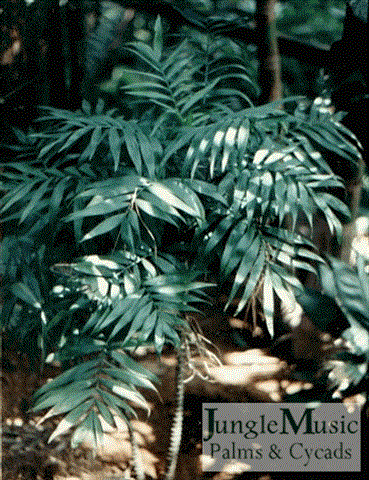
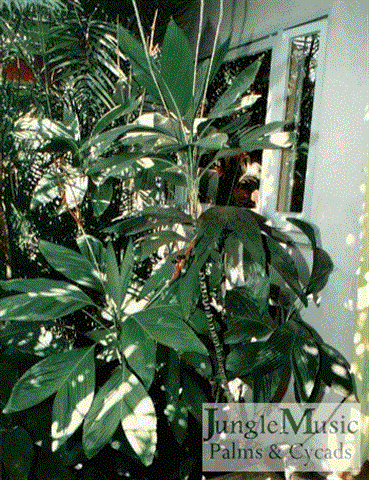
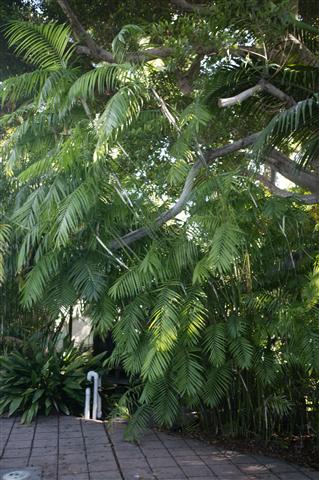
GENERAL APPEARANCE OF CHAMAEDOREA PALMS
As mentioned above, Chamaedorea is a very diverse group of palm trees. This is one of the most charming things about this family. The noted author on Chamaedorea palms is Don Hodel of UCLA in California. His book on the subject demonstrated the vast number of species in existence and the variability in their appearance and stature. I shall cover below certain morphology characteristics that all have in common, followed by some of the differences we see in the species. This is not meant to be a complete list, but enough to give the reader a feel for this genus. These represent my observations of this genus, and you will find that the list of differences is much longer than the list of common characteristics.
CHARACTERISTICS COMMON TO ALL OR MOST CHAMAEDOREAS:
Feather palms, none are fan palms
Tubular trunks that may be either very short or tall
New World plants, i.e. from the Americas
Understory palms (almost all) and prefer filtered light
Dioecious, meaning there are male and female plants
Green leaves although some may have an iridescent or metallic sheen
If trunking, all have prominent rings on the trunk
All are candidates for greenhouse, atrium or interior usage
All are beautiful in their own way

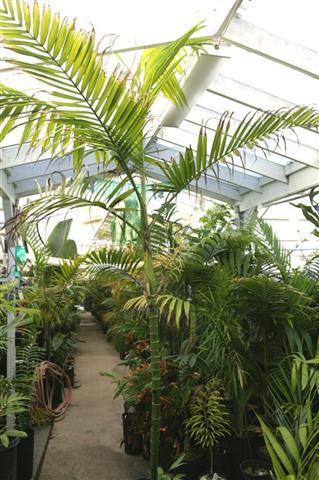
large species for the genus
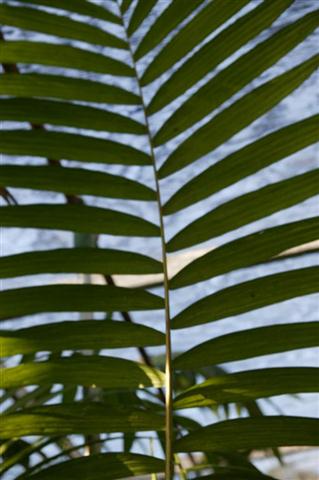
CHARACTERISTICS THAT DIFFER AMONG VARIOUS CHAMAEDOREAS
Some are short or even miniature while others are very tall and stout
Some have a modified pinnate leaf, taking on the simple or complete pair of leaflets appearing as if one leaflet; common with dwarf species.
Some have an obvious crown shaft while with others it is modified or almost absent.
Some are very compact while others have long stretching leaves
Some have a single trunk (majority) while others form clumps and are suckering
Some bear red fruit while others produce orange, black or other shades of fruit
Some species look totally different as an adult compared with their juvenile appearance
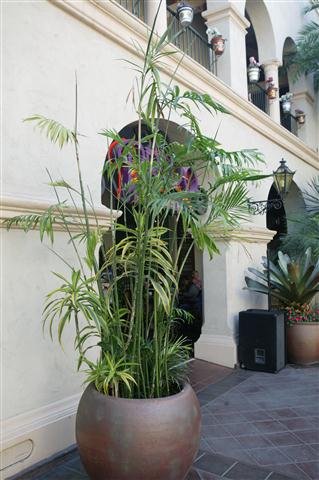
C. seifrizii
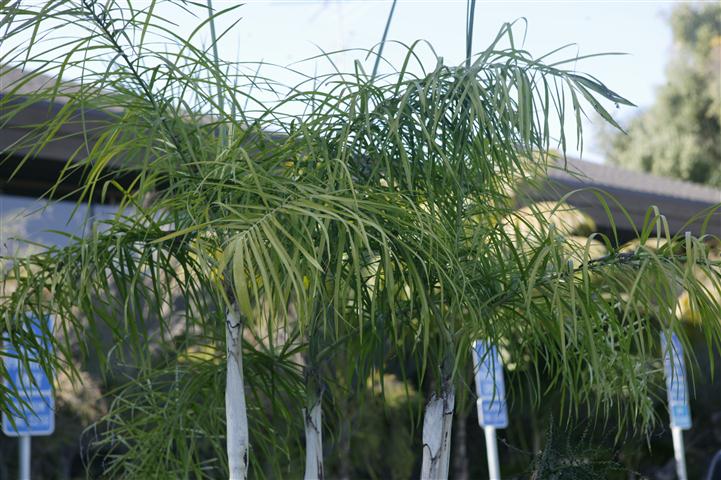
trunk species, C. glaucifolia
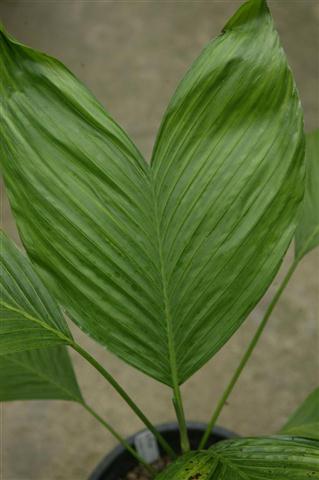
C. ernesti-augusti
.Below we shall discuss the different parts and characteristics of Chamaedorea so, as we discuss each species, the reader will understand the descriptions.
CHAMAEDOREA PINNATE LEAVES
All Chamaedorea are a pinnate leaf palm. Some refer to this as a “feather leaf”. This means that there is a central stem with leaflets coming off the side of that stem. The stem where leaflets are attached is called the rachis. The portion of the stem between the main trunk and the leaflets is called the petiole. Individual leaflets attach to the stem. As a whole, the entire structure is called a “leaf”, composed of many leaflets. Sometimes there are no divisions between the leaflets. When this occurs, it is called a simple leaf, an undivided leaf or a complete leaf. Of note, the width of leaflets is variable, some being very thin and others quite wide. Sometimes leaflets are grouped in bunches on the rachis. Other times they are widely separated. Sometimes the leaf as a whole is very flat in cross section. Other times the leaflets are projected at various angles from the rachis. This produces a fluffy or plumose type of leaf.
he main distinction here is that Chamaedorea are pinnate type leafs as opposed to a fan leaf. Length of these leaves is quite variable, some being less than 12 inches and others stretching out to almost 8 feet. In contrast, a fan palm leaf has a solid or near solid circular type leaf coming from the end of its leaf stem.
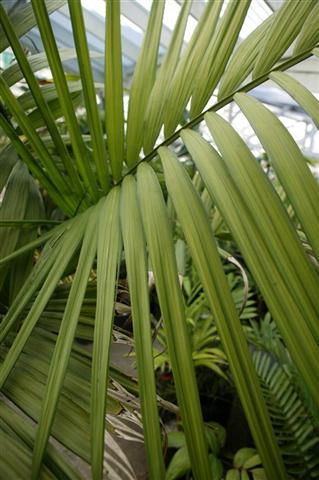
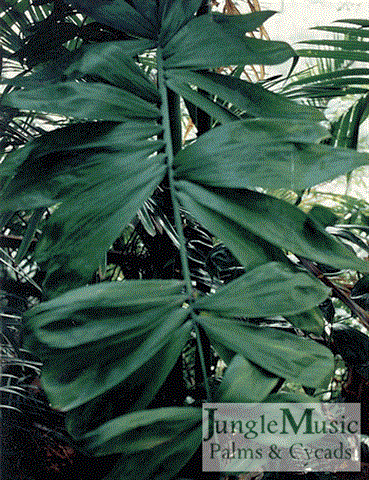


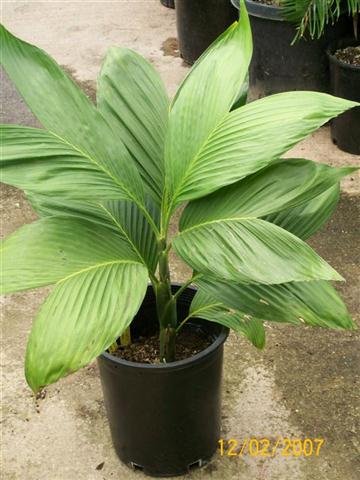
augustii

SOME CHAMAEDOREAS ARE SINGLE TRUNK, OTHER SUCKERING PALMS
A suckering palm (multi-stem palm) is one that naturally produces more than one vertical stem or trunk. Typically one trunk will form. At a certain age, from the bottom of the first trunk, additional trunks will appear. As they grow, the first trunk will usually be the tallest of the trunks until maturity is reached. A suckering palm may have two or three trunks or dozens. It is important to distinguish this from a single trunk species where the nurseryman puts more than one plant in the same pot. This gives the appearance of a suckering palm but is not one. Such a plant will never increase the number of trunks. In contrast, typically a suckering palm will continually over the years add more trunks to the plant. The classic Bamboo Palm is a suckering species.
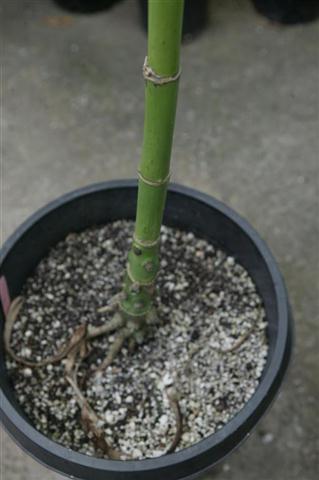
This plant will always have just one trunk.
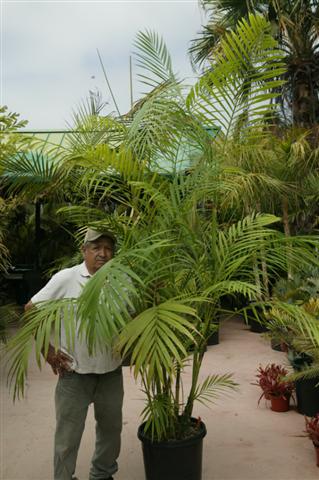
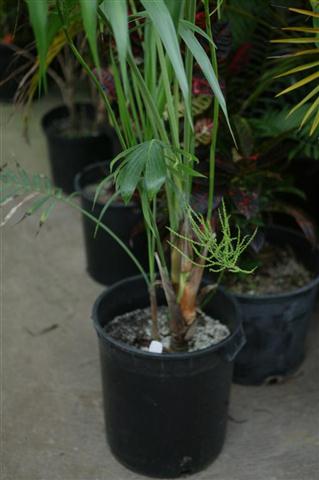
Note how new basilar stems are forming.

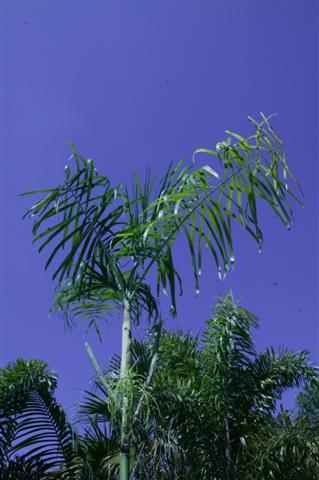
It is not a suckering species.
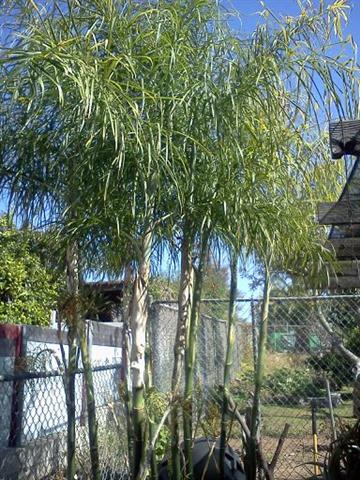
multiples for a fuller appearance
WHAT IS A CROWN SHAFT? MANY CHAMAEDOREA PALMS HAVE CROWN SHAFTS
This is a term that only applies to pinnate palms as fan palms in general do not posses crown shafts. Crown shafts (sometimes called “crown shaft” as two words) are tubular structures that are actually the proximal or base of a leaf stem. This portion of the stem wraps tightly around the main stem of the plant and forms a typically glossy, tight structure that wraps around the woody trunk. These structures may go around the entirety of the trunk or just part way around the trunk. When an old leaf is removed, this portion can be pulled off with the rest of the leaf. Crown shafts are seen in many palm genera and it is present on many species of Chamaedorea. Crown shaft color is typically green when present on Chamaedorea palms and the surface is usually smooth. However, colorful crown shafts are seen in other species of palms. Many enthusiasts love palms that display crown shaft, especially when they are colorful
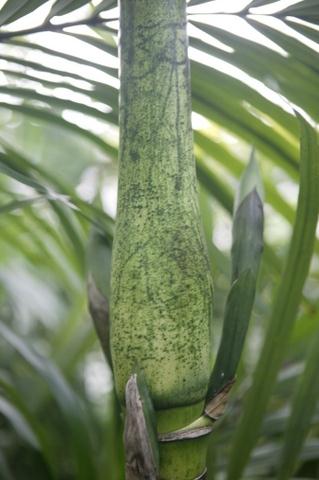
species Chamaedorea linearis
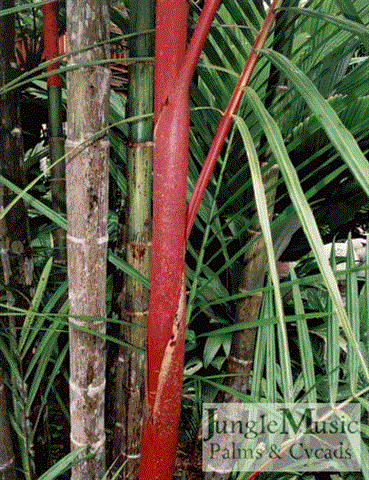
genus, Cyrtostachys renda
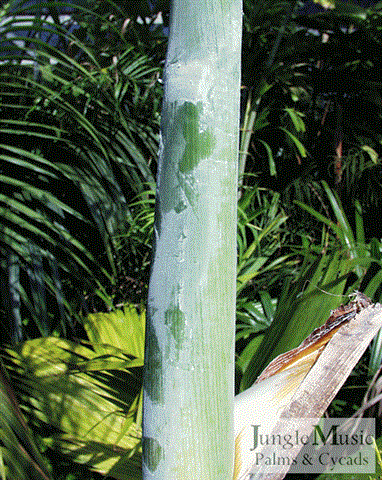
but covered with a white frost, giving it
a white appearance. Note how this wipes
off after being touched with fingers.
FLOWERS AND SEEDS OF CHAMAEDOREA
All Chamaedorea are dioecious. This means that any given plant is either a male or female plant. The flowers of each sex appear morphologically different and it is the characteristics of the flowers that allows taxonomists to determine the species of any given plant. As a rule with most species of Chamaedorea, the male flowers tend to be more branched than the female flowers. But, there are exceptions. Also, the male flowers disperse pollen that makes its way to the female to fertilize the embryos of the female and form seeds. This can be accomplished by wind, insects or mere proximity of the flowers. With some species, large amounts of pollen are formed in the male flowers. A flick of the winder against a mature male flower will produce a cloud of pollen dust that can be seen traveling away from the male. Such a species is Chamaedorea tepejilote. On seeing this, one can understand how wind could carry pollen to a waiting female receptive flower. Other species like Chamaedorea geonomiformis form an almost sticky pollen that doesn’t seem to be wind dispersed.
When flowers form on the trunks of the plants, they are attached to the trunk and near the lowest leaves or interspersed among the base of the leaves. They are often brilliant colors. Many times this color is orange and quite beautiful. After pollination, seeds take anywhere from three to six months to form and the resulting seeds are many colors including black, orange and red. Size of the seeds is variable, but typically about 1/8 to 1/2 inch in size. The colorful layer of fruit around the hard seed is typically removed before germination. Below are pictures of flowers and seeds from the very desirable Chamaedorea benzei. Although a single trunk plant, these are used as multiple plants in one pot to give the suckering appearance. The photos of the flowers are representative of Bamboo Palm flowers.
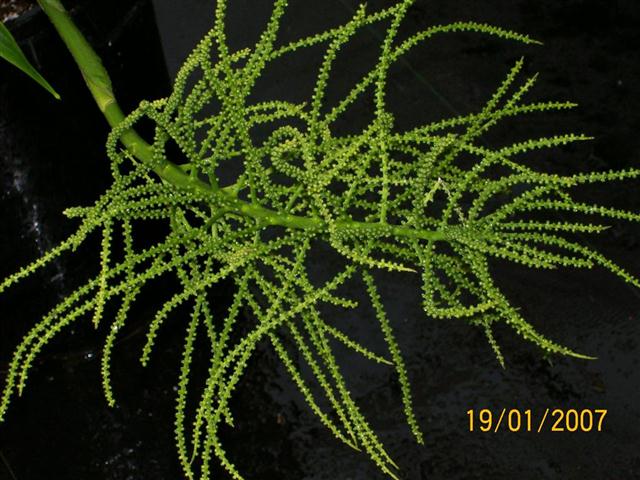
how the flower is quite branched.
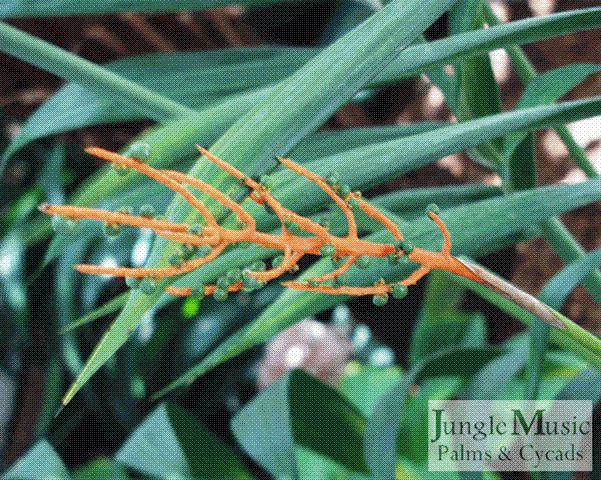
has a few immature seeds
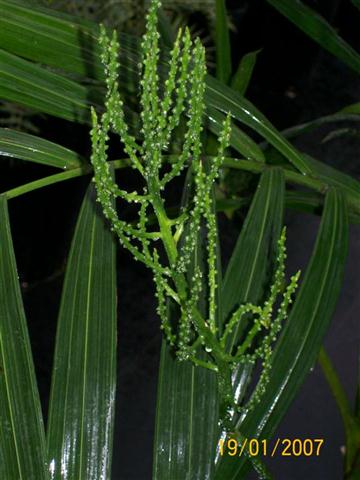
this flower is less branched than the male.
Very tiny immature fruit is forming.
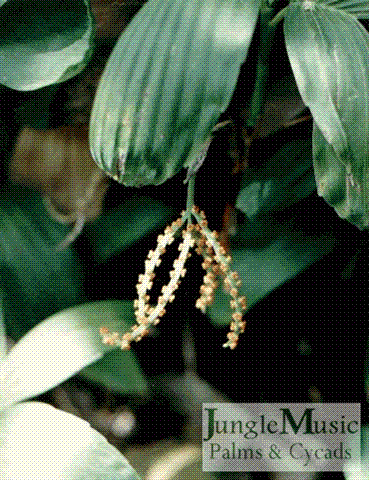
male blossom of Chamaedorea
stolinifera
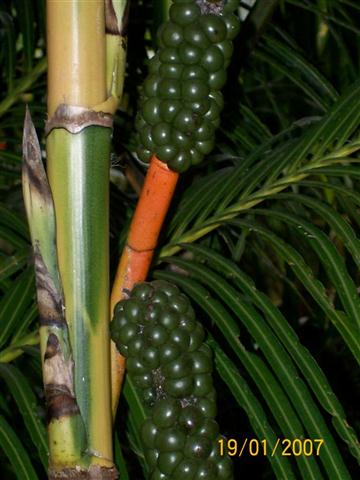
female blossom, C. arenbergiana
OVERALL SIZE AND TRUNK CHARACTERISTICS
Because of the diversity of this genus, trunk size and height is extremely varied. Trunk diameter can range from one quarter of an inch to almost six inches. And, heights can range from one foot to over twenty feet. Of the miniature species, Chamaedorea pumila and tuerckheimii are seldom over two feet in overall height. Chamaedorea woodsoniana has been reported to be as tall as forty feet with a diameter of four inches or more. In general, I’ve found that the thickest trunk species are the single stem species. The thickness of suckering species ranges from about 3/8 of an inch on some C. microspadix to about 1.5 inches on some types of C. costaricana.
Trunks are typically green and color and show prominent rings on their trunks. These appear at the point of attachment of removed leaf bases. Typically these rings are clean in appearance but sometimes bits of tissue from the leaf base may remain and look a bit untidy. If one forcefully pulls leaves from the trunk, resulting scars on the trunk below the rings can occur. And, these scars will be present for the life of the palm. Stem color is usually a shade green unless the palm is exposed to direct sunlight. Occasionally there is a mottling to the trunk color. Chamaedorea tepejilote is known for having very dark green trunk with light colored rings.
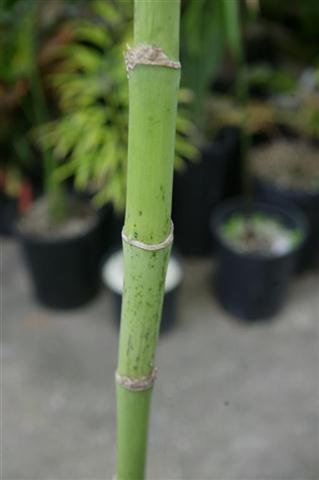
being from C. alternans
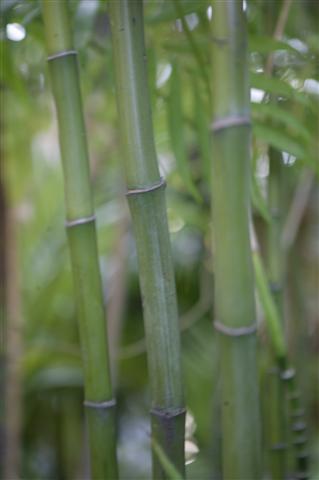
suckering Chamaedorea species
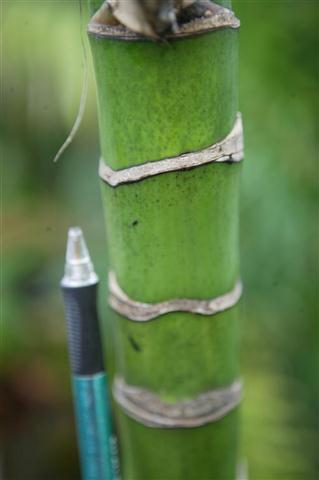
being from Chamaedorea lineari
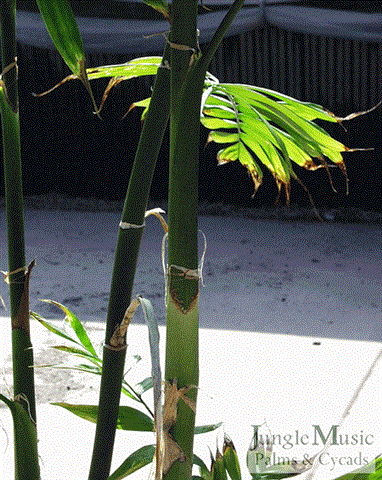
Chamaedorea volcanensis. Note
the retained leaf base debris.
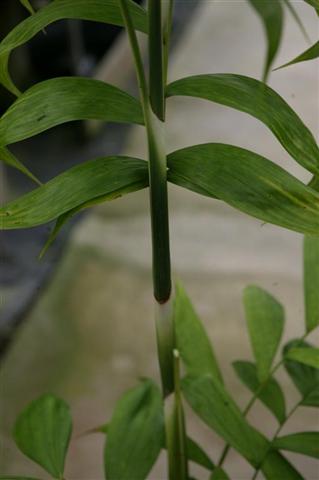
white coloring in the upper crown shaft
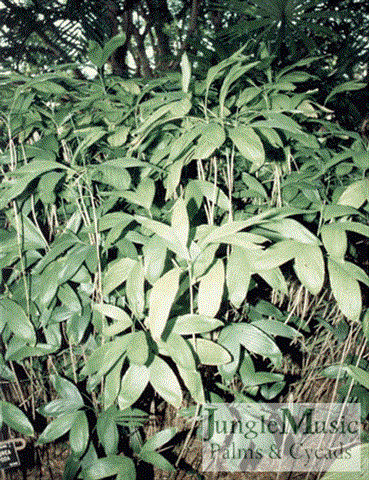
species Chamaedorea brachypoda
Trunks on Chamaedorea are usually erect or upright. As the plants mature, these trunks can lean to one side. Over time they can become nearly decumbent, almost laying on the ground. This is especially true with suckering species (typically thinner trunks) when they are quite tall and have many leaves. I think this is due to the mere weight of the crown causing the tall, often thin trunk to lean over. At times this can be quite aesthetic. But, in the garden, this does increase the spread of the clump. Chamaedorea microspadixare especially susceptible to trunks leaning out as they get very old and mature. This is partly due to their very thin trunks. Suckering Chamaedorea with thicker trunks seem to have less of this tendency. Light may also play a part in this as some trunks seem to be “leaning” for more light.

this suckering species are leaning
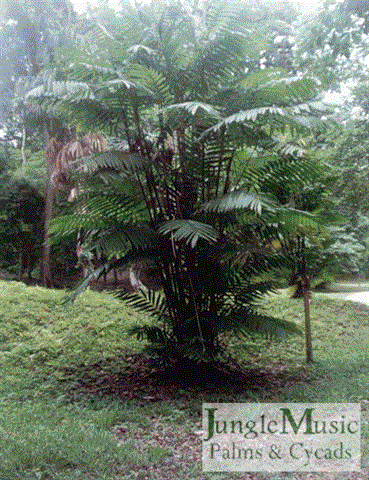
exposed suckering Chamaedorea with
strong thick trunks
CULTURE AND CARE OF CHAMAEDOREA PALMS
SUNLIGHT:
In general, it is safe to assume that Chamaedorea palms prefer filtered light. By this, I mean very little in the way of direct sunlight. Underneath larger overhead trees would be a great example of filtered light. I should contrast this to “part day sun” which might be two or three hours of direct sun followed by shade. unfortunately, sometimes these few hours of direct light might be too much for certain types of Chamaedorea. This is especially true if you live in an inland area. Morning sun is the most forgiving if a plant is to receive part day sun.
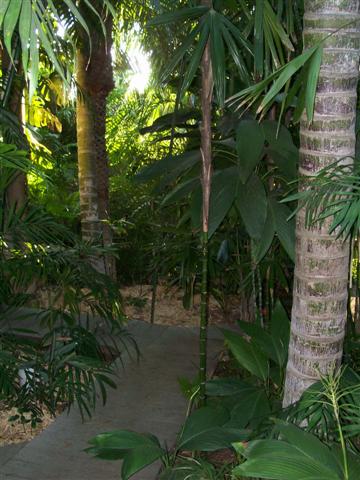
garden for Chamaedorea palms.
There are several species of Chamaedoreas that can tolerate full or near full day sun. These include Chamaedorea plumosa, glaucifolia, radicalis (regular and trunking form), and benzei and are known to take full sun along the coast. I’ve even had reports of Chamaedorea costaricana tolerating full sun when not in environments near the ocean. For those who live in far inland areas, figure that all species prefer filtered light.
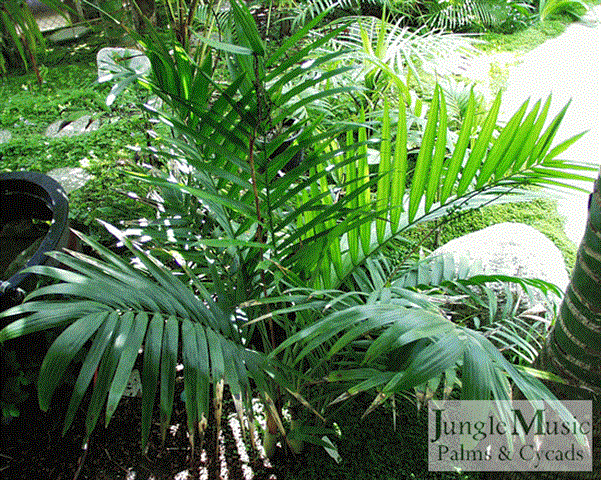
in some coastal areas.
SOIL
Most Chamaedoreaslike soil rich in organics and which have good drainage. Things such as mulch, fir shavings, compost, etc. will help add organics to an overly sandy or clay soil. Coarse material such as pumice, large grain sand, or decomposed granite can promote drainage. Bark can be used as well, but it’s addition is short-lived as the woody material rots over time. For container grown Chamaedorea, I would recommend a combination of topsoil with adequate organics and sand, making sure drainage is not slow.
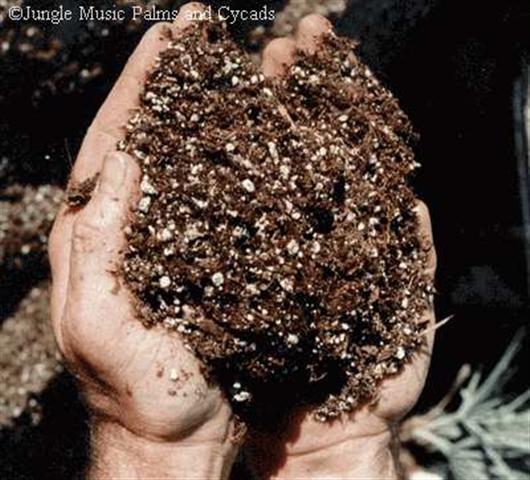
organic material
WATER:
Chamaedorea like adequate water but do not prefer wet soppy soil. When there is good drainage, a watering frequency of three times a week in warm weather should prove to be adequate. For container grown plants, water when the top inch of soil just starts to dry out. Water heavy in minerals or salts will give many Chamaedorea tip burn. If you see this, figure your problem is either too little water (desiccation) or high salt load in the water you are using. Also, too much fertilizer gives tip burning. For plants grown in the house, consider distilled or reverse osmosis water. If this is not possible, leach out the salts with heavy multiple cycles of water ever several months.
AIR CIRCULATION:
All species of Chamaedorea like good ventilation. Outdoors, veentilation is not usually a problem. But, inside the house poor ventilation can be seen and lead o insect problem, especially spider mites. Opening windows or having interior fans can assist with air movement.
FERTILIZER:
I prefer slow release fertilizers with an N/P/K ration of approximately 3:1:3 or 3:1:2. Therefore, a formula of 12:4:12 or 12:4:8 would be perfect. Also, try to get a preparation that containers microelements. If you plants are getting yellow chronically, also consider a dose of blood meal (contains nitrogen and iron); usually this greens up leaves in three to four months.
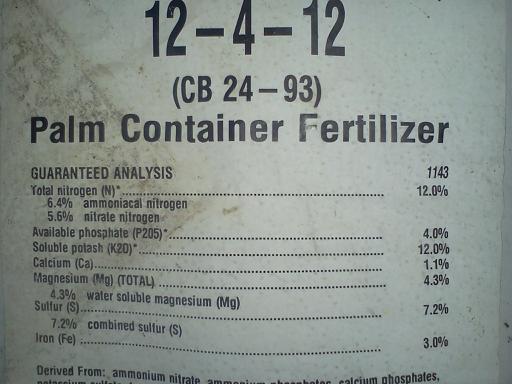
with microelement
PRUNING: I recommend cutting off old leaves when they are unsightly or brown. One typically sees this on the lower leaves first. Therefore, in almost all cases, the lowest and oldest leaves are removed first, from the bottom up. Removal of newer leaves which are in the middle of the crown leads to death of the leaf base. Thus, between viable and living leaves, one has tissue that is dying. This could lead to stem rot. One can easily trim off brown tipping at the ends of the leaflets. This is best done with a pair of sharp scissors. You are “giving the plant a haircut”.
As a Chamaedorea leaf dies, the leaf base that wraps around the trunk also discolors and eventually turns brown and becomes brittle. If this dying process is complete, the leaf base can be pulled off the trunk quite easily. If the old leaf base is still green, it will not come off easily. Removing these old leaf bases should be an easy thing. If you are having to pull hard at it or use pruners, it’s not ready to come off. Too early removal of old leaf bases can lead to permanent scars on the trunk, especially if one pulls downward and removes the superficial layers of the out stem tissue. The photos below show old leaf bases that are ready for removal. Also shown in the third photos are permanent scars to the trunk from forcing off a leaf base (center trunk).
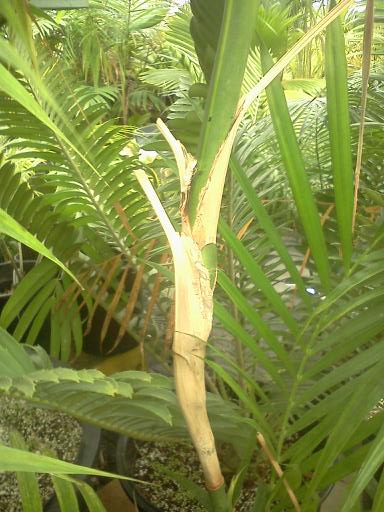
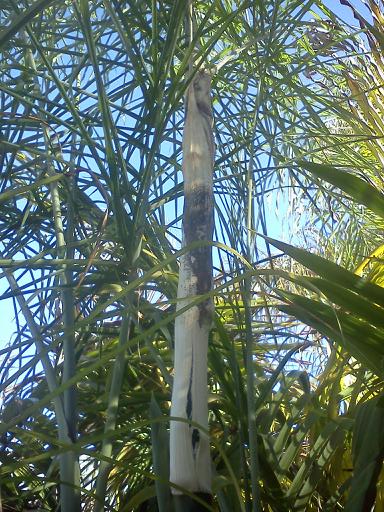
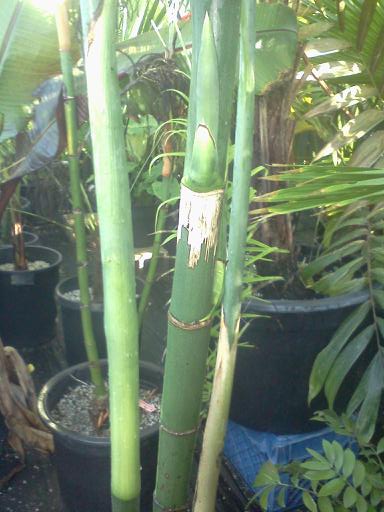
TO SEE MORE ON THESE PLANTS – CHECK OUT THE NEXT ARTICLE
THE CHAMAEDOREA SPECIES WITH DESCRIPTIONS AND PHOTOS: CLICK HERE
Thank you for reading this article. We’ll try to update some photos over time. For more information on Chamaedorea as a group with more precise information on usage and care,click below on two more articles on the subject.
OF NOTE: WE HAVE MANY OR ALL OF THE ABOVE SPECIES EITHER AVAILABLE NOW OR IN THE FUTURE
Phil Bergman
Owner
- PALM TREES, CYCADS & TROPICAL PLANT BLOG - October 1, 2020
- TRACHYCARPUS
The Windmill Palm - September 30, 2020 - FAN PALMS –
PALMS WITH CIRCULAR LEAVES - September 29, 2020












